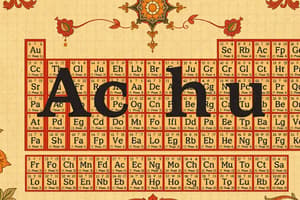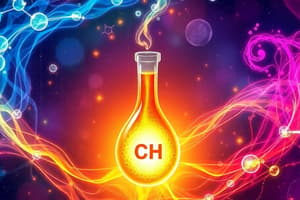Podcast
Questions and Answers
What is a key factor that affects the rate of chemical reactions?
What is a key factor that affects the rate of chemical reactions?
- Concentration of reactants (correct)
- Color of the reactants
- Molecular weight of reactants
- Physical state of the product
What does Le Chatelier's Principle state about a system in equilibrium?
What does Le Chatelier's Principle state about a system in equilibrium?
- The system will remain unchanged after a disturbance
- The system will shift to maximize disturbance effects
- The system shifts to counteract disturbances (correct)
- The rates of all reactions are equal
What distinguishes isomers from one another?
What distinguishes isomers from one another?
- Same physical properties
- Different molecular formulas
- Different functional groups present
- Same molecular formula with different structural arrangements (correct)
What is the definition of a mole in chemistry?
What is the definition of a mole in chemistry?
Which of the following is considered Personal Protective Equipment (PPE) in chemistry?
Which of the following is considered Personal Protective Equipment (PPE) in chemistry?
Which of the following correctly describes elements?
Which of the following correctly describes elements?
What type of bond is formed by the sharing of electrons between atoms?
What type of bond is formed by the sharing of electrons between atoms?
Which reaction type involves one element replacing another in a compound?
Which reaction type involves one element replacing another in a compound?
What is the state of matter characterized by having a definite volume but no definite shape?
What is the state of matter characterized by having a definite volume but no definite shape?
What type of reaction absorbs heat from the surroundings?
What type of reaction absorbs heat from the surroundings?
Which of the following statements regarding acids is true?
Which of the following statements regarding acids is true?
What do the groups or families on the periodic table have in common?
What do the groups or families on the periodic table have in common?
What does the pH scale measure?
What does the pH scale measure?
Flashcards are hidden until you start studying
Study Notes
Basic Concepts in Chemistry
- Atoms: Basic unit of matter, made up of protons, neutrons, and electrons.
- Elements: Pure substances consisting of one type of atom, each identified by its atomic number.
- Compounds: Substances formed from two or more elements chemically combined in fixed proportions.
The Periodic Table
- Groups/Families: Columns that share similar properties (e.g., alkali metals, halogens).
- Periods: Rows corresponding to the number of electron shells an atom has.
- Metals, Nonmetals, Metalloids: Metals are good conductors; nonmetals are poor conductors; metalloids have properties of both.
Chemical Bonds
- Ionic Bonds: Formed when electrons are transferred between atoms, resulting in charged ions.
- Covalent Bonds: Formed when atoms share electrons.
- Metallic Bonds: Bonds formed by the attraction between free electrons and metal ions.
Chemical Reactions
- Types of Reactions:
- Synthesis: Two or more reactants combine to form one product.
- Decomposition: One compound breaks down into two or more simpler substances.
- Single Replacement: One element replaces another in a compound.
- Double Replacement: Exchange of ions between two compounds.
- Combustion: Reaction with oxygen producing heat and light; typically produces CO2 and H2O.
- Law of Conservation of Mass: Mass is neither created nor destroyed in a chemical reaction.
States of Matter
- Solid: Definite shape and volume, particles are closely packed and vibrate in place.
- Liquid: Definite volume but takes the shape of the container, particles are close but can move past one another.
- Gas: No definite shape or volume, particles are far apart and move freely.
- Plasma: Ionized gas with free electrons and ions, found in stars.
pH and Acids/Bases
- pH Scale: Measures acidity or alkalinity (0-14 scale, <7 is acidic, >7 is basic).
- Acids: Substances that donate protons (H+) in a solution; have a sour taste.
- Bases: Substances that accept protons; have a bitter taste and slippery feel.
Thermochemistry
- Endothermic Reactions: Absorb heat from the surroundings.
- Exothermic Reactions: Release heat to the surroundings.
- Enthalpy (ΔH): The heat content of a system at constant pressure.
Chemical Kinetics
- Reaction Rate: The speed at which reactants are converted to products.
- Factors Affecting Reaction Rate:
- Concentration of reactants
- Temperature
- Surface area of reactants
- Presence of catalysts
Chemical Equilibrium
- Dynamic Equilibrium: A state where the rate of the forward reaction equals the rate of the reverse reaction.
- Le Chatelier's Principle: If a system at equilibrium is disturbed, the system shifts in a direction that counteracts the disturbance.
Organic Chemistry
- Hydrocarbons: Compounds composed solely of hydrogen and carbon.
- Functional Groups: Specific groups of atoms that confer characteristic properties to organic compounds (e.g., -OH for alcohols, -COOH for carboxylic acids).
- Isomers: Compounds with the same molecular formula but different structural arrangements.
Stoichiometry
- Mole: Fundamental unit in chemistry, represents a specific number of particles (6.022 x 10^23).
- Balanced Equations: Representation of chemical reactions showing equal numbers of each type of atom on both sides.
Safety in Chemistry
- Personal Protective Equipment (PPE): Use gloves, goggles, and lab coats to minimize exposure to hazardous materials.
- Proper Disposal: Follow guidelines for disposing of chemical waste to prevent environmental contamination.
Basic Concepts in Chemistry
- Atoms are the fundamental building blocks of matter. They comprise three main subatomic particles: protons, neutrons, and electrons.
- Elements, like hydrogen and oxygen, are pure substances composed of only one type of atom, defined by their unique atomic number.
- Compounds, such as water (H2O), are formed by the chemical combination of two or more elements in fixed proportions.
The Periodic Table
- The periodic table organizes elements based on their properties and electron configurations.
- Groups or families, represented by columns, consist of elements with similar chemical properties due to their similar electron configurations.
- Periods are rows that correspond to the number of electron shells an atom has, indicating its energy level.
- Elements are broadly classified into metals which are typically good conductors of heat and electricity, nonmetals which tend to be poor conductors, and metalloids that exhibit properties of both metals and nonmetals.
Chemical Bonds
- Ionic bonds are formed by the transfer of electrons between atoms, resulting in oppositely charged ions that attract each other.
- Covalent bonds involve the sharing of electrons between atoms, leading to a more stable configuration for both atoms.
- Metallic bonds result from the attraction between free-moving electrons and positively charged metal ions, contributing to the characteristic properties of metals like conductivity.
Chemical Reactions
- Synthesis Reactions involve the combination of two or more reactants to form a single product.
- Decomposition Reactions are the opposite, where a single compound breaks down into two or more simpler substances.
- Single Replacement Reactions occur when one element replaces another in a compound.
- Double Replacement Reactions involve the exchange of ions between two compounds.
- Combustion is a chemical reaction involving rapid reaction with oxygen, producing heat and light. It commonly results in the formation of carbon dioxide (CO2) and water (H2O).
- The Law of Conservation of Mass states that mass is neither created nor destroyed in a chemical reaction, only transformed from one form to another.
States of Matter
- Solids have a fixed shape and volume due to closely packed particles that vibrate in place.
- Liquids have a definite volume but take the shape of their container, as particles are close but can move past one another.
- Gases lack a fixed shape or volume because their particles are far apart and move freely.
- Plasma, often referred to as the fourth state of matter, is an ionized gas with free electrons and ions, commonly found in stars.
pH and Acids/Bases
- The pH scale, ranging from 0-14, quantifies the acidity or alkalinity of a solution. A pH of 7 is neutral.
- Acids donate protons (H+) in a solution, generally having a sour taste.
- Bases accept protons, typically having a bitter taste and a slippery feel.
Thermochemistry
- Endothermic Reactions absorb heat from their surroundings, resulting in a decrease in temperature.
- Exothermic Reactions release heat to their surroundings, leading to an increase in temperature.
- Enthalpy (ΔH) represents the heat content of a system under constant pressure, providing a measure of the heat absorbed or released during a reaction.
Chemical Kinetics
- The Reaction Rate refers to the speed at which reactants are converted into products.
- Factors Affecting Reaction Rate include:
- Concentration of reactants: Higher concentration generally leads to faster reactions.
- Temperature: Increased temperature usually accelerates reactions.
- Surface area of reactants: Greater surface area provides more contact points, enhancing the reaction rate.
- Presence of catalysts: Catalysts speed up reactions without being consumed in the process.
Chemical Equilibrium
- Dynamic Equilibrium describes a state where the rate of the forward reaction equals the rate of the reverse reaction.
- Le Chatelier's Principle states that if a system at equilibrium is subjected to a change in conditions, the system will shift in a direction that counteracts the disturbance.
Organic Chemistry
- Hydrocarbons are organic compounds composed solely of hydrogen and carbon atoms.
- Functional Groups are specific groups of atoms within organic molecules that confer characteristic properties. Examples include the -OH (hydroxyl) group in alcohols and the -COOH (carboxyl) group in carboxylic acids.
- Isomers are molecules with the same molecular formula but different structural arrangements, leading to varying properties.
Stoichiometry
- Mole (mol) is the fundamental unit in chemistry, representing a specific number of particles (6.022 x 10^23), known as Avogadro's number.
- Balanced Equations are chemical equations representing reactions that ensure an equal number of each type of atom on both sides of the equation.
Safety in Chemistry
- Personal Protective Equipment (PPE), including gloves, goggles, and lab coats, is essential for minimizing exposure to hazardous materials during laboratory work.
- Proper Disposal of chemical waste according to established guidelines is crucial to preventing environmental contamination.
Studying That Suits You
Use AI to generate personalized quizzes and flashcards to suit your learning preferences.




